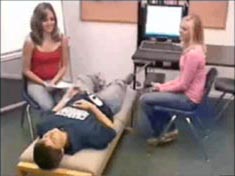S03 ECG1 Components of the ECG

ECG 1 introduces the electrocardiograph and the recording of the hearts electrical signal. Students learn about Lead II ECG recording and the components of the ECG complex. They also learn to correlate the electrical events of the ECG (P, Q, R, S, and T components) with the mechanical events of the cardiac cycle. After performing a number of tasks designed to promote changes in the ECG complex, students analyze their own ECG recording.
Experimental Objectives
-
To become familiar with the electrocardiograph as a primary tool for evaluating electrical events within the heart.
-
To observe rate and rhythm changes in the ECG associated with body position and breathing.
Tasks Performed by the Student
-
Lie down and relax.
-
Take five deep breaths.
-
Perform a physical exercise to increase heart rate.
-
Relax while heart rate returns to normal.
Videos
Biopac Student Lab Student Download
Student Prep & Distance Learning
Click the link(s) below for sample data and/or lesson procedure video(s), BSL PRO Lesson procedures (PDF) for human lessons*, and graph template files (*.gtl) for BSL PRO Lessons. If more than one .gtl is available, download the .gtl with the _suffix to match BSL version and hardware.
WHAT'S NEW
Biology research covers a wide variety of studies all aiming to understand living organisms...
Stay Connected